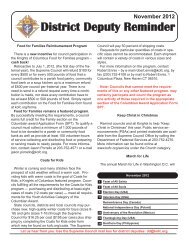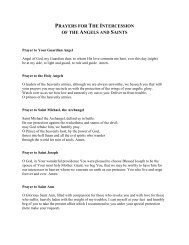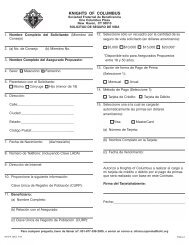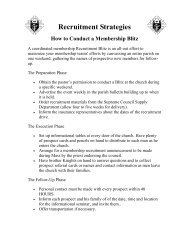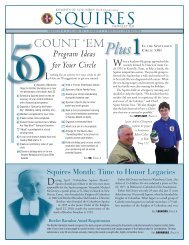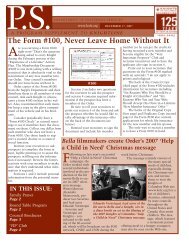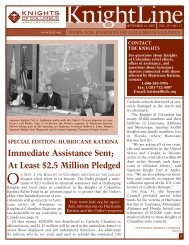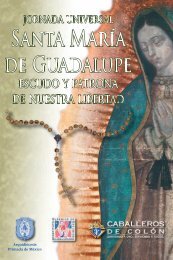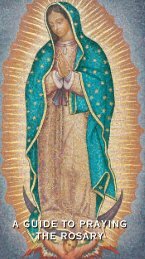CATHOLIC WORD BOOK - Knights of Columbus, Supreme Council
CATHOLIC WORD BOOK - Knights of Columbus, Supreme Council
CATHOLIC WORD BOOK - Knights of Columbus, Supreme Council
You also want an ePaper? Increase the reach of your titles
YUMPU automatically turns print PDFs into web optimized ePapers that Google loves.
Situation Ethics: A subjective, individualistic<br />
ethical theory which denies the binding<br />
force <strong>of</strong> ethical principles as universal laws<br />
and preceptive norms <strong>of</strong> moral conduct,<br />
and proposes that morality is determined<br />
only by situational conditions and<br />
considerations and the intention <strong>of</strong> the<br />
person. It has been criticized for ignoring<br />
the principles <strong>of</strong> objective ethics. (See also<br />
Consequentialism and Proportionalism.)<br />
Slander: Attributing to a person faults<br />
which he or she does not have; a violation<br />
<strong>of</strong> the obligations <strong>of</strong> justice and charity, for<br />
which restitution is due.<br />
Sloth (Acedia): One <strong>of</strong> the seven capital<br />
sins; spiritual laziness, involving distaste<br />
and disgust for spiritual things; spiritual<br />
boredom, which saps the vigor <strong>of</strong> spiritual<br />
life. Physical laziness is a counterpart <strong>of</strong><br />
spiritual sloth.<br />
Sorcery: A kind <strong>of</strong> black magic in which<br />
evil is invoked by means <strong>of</strong> diabolical<br />
intervention; a violation <strong>of</strong> the virtue <strong>of</strong><br />
religion.<br />
Soteriology: The division <strong>of</strong> theology<br />
which treats <strong>of</strong> the mission and work <strong>of</strong><br />
Christ as Redeemer.<br />
Species, Sacred: The appearances <strong>of</strong> bread<br />
and wine (color, taste, smell, etc.) which<br />
remain after the substance has been<br />
changed at the Consecration <strong>of</strong> the Mass<br />
into the Body and Blood <strong>of</strong> Christ. (See<br />
Transubstantiation.)<br />
Spiritism: Attempts to communicate with<br />
spirits and departed souls by means <strong>of</strong><br />
seances, table tapping, ouija boards, and<br />
other methods; a violation <strong>of</strong> the virtue <strong>of</strong><br />
-66-<br />
religion. Spiritualistic practices are noted<br />
for fakery.<br />
Stational Churches, Days: Churches,<br />
especially in Rome, where the clergy and<br />
lay people were accustomed to gather with<br />
their bishop on certain days for the<br />
celebration <strong>of</strong> the liturgy. The 25 early<br />
titular or parish churches <strong>of</strong> Rome, plus<br />
other churches, each had their turn as the<br />
site <strong>of</strong> divine worship in practices which<br />
may have started in the third century. The<br />
observances were rather well developed<br />
toward the latter part <strong>of</strong> the 4th century,<br />
and by the fifth they included a Mass<br />
concelebrated by the pope and attendant<br />
priests. On some occasions, the stational<br />
liturgy was preceded by a procession from<br />
another church called a collecta. There were<br />
42 Roman stational churches in the 8th<br />
century, and 89 stational services were<br />
scheduled annually in connection with the<br />
liturgical seasons. Stational observances<br />
fell into disuse toward the end <strong>of</strong> the<br />
Middle Ages. Some revival was begun by<br />
John XXIII in 1959 and continued by<br />
Paul VI and John Paul II.<br />
Stations (Way) <strong>of</strong> the Cross: A form <strong>of</strong><br />
devotion commemorating the Passion and<br />
death <strong>of</strong> Christ, consisting <strong>of</strong> a series <strong>of</strong><br />
meditations (stations): (1) his<br />
condemnation to death, (2) taking up <strong>of</strong><br />
the cross, (3) the first fall on the way to<br />
Calvary, (4) meeting his Mother, (5) being<br />
assisted by Simon <strong>of</strong> Cyrene and (6) by the<br />
woman Veronica who wiped his face, (7)<br />
the second fall, (8) meeting the women <strong>of</strong><br />
Jerusalem, (9) the third fall, (10) being<br />
stripped and (11) nailed to the cross, (12)<br />
his death, (13) the removal <strong>of</strong> his body<br />
from the cross and (14) his burial.<br />
Depictions <strong>of</strong> these scenes are mounted in




